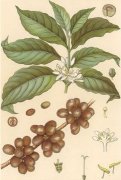Baking knowledge of coffee roasting boutique coffee beans

Concept:
Roasting is about the boiling of coffee beans, creating the unique color (amber), flavor and aroma of coffee. Roasting turns the light green raw coffee beans into the tea-brown coffee beans we are familiar with. High-standard fried roasting refers to the ingenious expression of the aroma, sour and bitter taste of raw coffee beans.
Countries tend to bake:
Cities all over the world have their preferred baking tendency.
In Tokyo, micro-deep medium baking is more popular, but slowly it also tends to deep baking. As for Kansai, deep baking has been popular in the past.
New York, as its name suggests, generally prefers urban baking, but because the city is inhabited by different races of people, it also sells coffee beans with different roasting degrees, and the variety is also quite rich.
Vienna prefers deep baking. Even as the name suggests, the French prefer French baking, while Italians often use Italian baking.
However, in recent years, Italian baking (the most commonly used deep roasting in Brazil and Italy) has been widely used in Europe and the United States, and the coffee made by steam pressurizer is still popular.
Deep roasting of Ethiopian coffee beans would be a waste. Because that would lose the unique characteristics of this coffee. Black roasting of Yauco and Kona coffee beans is also bad, because you will lose the classical flavor you pursue when you buy it.
When some coffee beans are roasted black, new and interesting qualities will be derived. Mexican coffee beans produce an interesting sweetness when roasted in black.
Guatemala Antigua coffee beans seem to retain their sour and fruity flavor when they are deeply roasted, which is difficult for other coffees.
Sumatran coffee beans are usually full-grained, but are below medium acidity, lose acidity when roasted deeper, and easily turn into sugar paste.
Generally speaking, the darker the baking, the lower the quality. Deeper roasting means losing most of the flavor of the coffee beans.
Research on coffee roasting technology:
A series of chemical changes occur in the process of baking. After about 15 minutes of baking, the green coffee beans lose moisture, turn yellow, and then burst like popcorn. After this process, the coffee beans will double in size and begin to show a light brown after stir-frying. After this stage is completed (after about 8 minutes of baking), the calories will be reduced. The color of the coffee soon changed to dark. When the preset baking degree is reached, cold air can be used to stop baking to achieve rapid cooling.
The roasting method of professional coffee is usually divided into the following eight stages.
1. Very shallow baking (LIGHTRoast): the degree of baking; very shallow baking, also known as shallow baking. The lightest roasting degree of all roasting stages, the surface of the coffee beans is a light cinnamon color, its taste and aroma are insufficient, this state is almost undrinkable. It is generally used for testing and seldom for tasting. 2. Shallow baking (CINNAMONRoast): baking degree; shallow baking, also known as cinnamon baking. The general baking degree, showing cinnamon color on the appearance, the smell of green has been removed, the aroma is OK, and the acidity is strong, which is a common roasting degree of American coffee. 3. MEDIUMRoast: degree of baking; moderate baking, also known as micro-baking. Medium baking heat and light baking are both American, in addition to sour taste, bitterness also appears, the taste is good. It has moderate aroma, acidity and mellowness, and is often used in the baking of mixed coffee. 4. Medium baking (HIGHRoast): baking degree; moderate micro-deep baking, also known as concentration baking. Belongs to the moderate micro-deep baking, the baking degree is slightly stronger than the slight medium baking, the surface has appeared a little thick brown, the bitterness also becomes stronger. Coffee tastes sour and bitter, with good aroma and flavor, and is most often loved by people in Japan and Central Europe. (blue Mountain Coffee) 5. Medium and deep roasting (CITYRoast): degree of roasting; medium and deep roasting, also known as urban roasting. The most standard degree of roasting, bitterness and acidity are balanced and are often used in French coffee. (Brazil, Colombia) 6. Deep baking (FULL-CITYRoast): degree of baking; micro-deep baking, also known as deep city baking. The baking degree is slightly stronger than the medium depth, the color becomes quite dark, and the bitter taste is stronger than the sour taste. It belongs to the Central and South American baking method, which is very suitable for preparing all kinds of iced coffee. 7. Deep baking (FrenchRoast): degree of baking; deep baking, also known as French baking. Also known as French or European baking, belongs to deep baking, the color is thick brown with black, sour taste can not be felt, especially in Europe, France is the most popular, because the fat has infiltrated to the surface, with a unique flavor, very suitable for coffee Oulei, Viennese coffee. 8. Deep baking (ItalianRoast): the degree of baking; very deep baking, also known as Italian baking. Also known as Italian baking, baking degree before carbonization, there is a scorched taste, mainly popular in Latin countries, suitable for fast coffee and cappuccino. Most of them are used in Espresso coffee series.
Important Notice :
前街咖啡 FrontStreet Coffee has moved to new addredd:
FrontStreet Coffee Address: 315,Donghua East Road,GuangZhou
Tel:020 38364473
- Prev

The benefits of coffee black coffee is the healthiest coffee
As one of the coffee lovers, you are no stranger to coffee culture, are you? Within 30 minutes to 1 hour after lunch, taste a full-bodied cup of coffee without sugar and partner, which helps digestion after meals and promotes fat burning. Before getting off work, have another cup of coffee and go for a walk. Tips for slimming Coffee Don't add sugar: if you're not used to the bitterness of coffee, you can add a little
- Next

Definition of Coffee Tree basic knowledge of Fine Coffee
Coffee trees are evergreen shrubs with slender trunks and many branches. In order to facilitate harvesting, coffee trees on the farm are usually maintained at about 1.5 meters. Wild coffee trees may grow to seven or eight meters, or even as high as 10 meters. After the coffee is planted, it will take about five years to grow, blossom and bear fruit for the first time for farmers to harvest. In this long five years, the seeder can only expect; the burden of the backlog of funds.
Related
- Beginners will see the "Coffee pull flower" guide!
- What is the difference between ice blog purified milk and ordinary milk coffee?
- Why is the Philippines the largest producer of crops in Liberia?
- For coffee extraction, should the fine powder be retained?
- How does extracted espresso fill pressed powder? How much strength does it take to press the powder?
- How to make jasmine cold extract coffee? Is the jasmine + latte good?
- Will this little toy really make the coffee taste better? How does Lily Drip affect coffee extraction?
- Will the action of slapping the filter cup also affect coffee extraction?
- What's the difference between powder-to-water ratio and powder-to-liquid ratio?
- What is the Ethiopian local species? What does it have to do with Heirloom native species?

